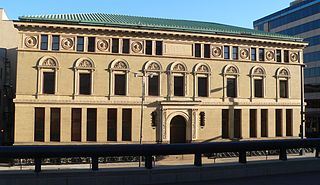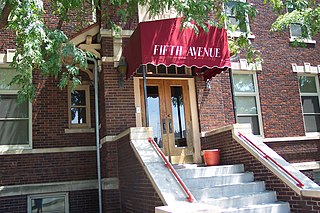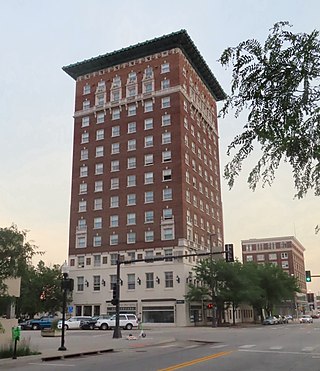
The Drake Court Apartments and the Dartmore Apartments Historic District, built between 1916 and 1921, is located at Jones Street from 20th to 23rd Streets in Midtown Omaha, in the U.S. state of Nebraska. Built in combined Georgian Revival, Colonial Revival and Prairie School styles, the complex was designated a City of Omaha Landmark in 1978; it was listed on the National Register of Historic Places as a historic district in 1980. The historic district originally included 6.5 acres (2.6 ha) with 19 buildings. In 2014, boundary of the historic district was expanded by 0.74 acres (0.30 ha) include three additional buildings, and decreased by 3 acres (1.2 ha) to remove open space and parking that had been re-purposed, for a new total of 4.24 acres (1.72 ha). The district was also renamed to Drake Court Historic District.

The Bemis Park Landmark Heritage District is located in North Omaha, Nebraska. Situated from Cuming Street to Hawthorne Avenue, Glenwood Avenue to 33rd Street, Bemis Park was annexed into Omaha in 1887, and developed from 1889-1922. The district was designated an Omaha Landmark in 1983.

The Sherman is a historically significant apartment building located at 2501 North 16th Street in the Near North Side of Omaha, Nebraska. Built in 1897, it was designated an Omaha landmark in 1985; in 1986 it was listed on the National Register of Historic Places.

The Livestock Exchange Building in Omaha, Nebraska, was built in 1926 at 4920 South 30 Street in South Omaha. It was designed as the centerpiece of the Union Stockyards by architect George Prinz and built by Peter Kiewit and Sons in the Romanesque revival and Northern Italian Renaissance Revival styles. In 1999 it was designated an Omaha Landmark and listed on the National Register of Historic Places. The Union Stockyards were closed in 1999, and the Livestock Exchange Building underwent an extensive renovation over the next several years.

The Christian Specht Building is located at 1110 Douglas Street in downtown Omaha, Nebraska. It is the only existing building with a cast-iron facade known in Nebraska today, and one of the few ever built in the state. The building was deemed an Omaha landmark in 1981, and was listed on the National Register of Historic Places in 1977.

The Melrose Apartments were built in 1916 at 602 North 33rd Street in the Gifford Park neighborhood of Omaha, Nebraska. The Melrose was listed on the National Register of Historic Places in 1989.

Downtown Omaha is the central business, government and social core of the Omaha-Council Bluffs metropolitan area, U.S. state of Nebraska. The boundaries are Omaha's 20th Street on the west to the Missouri River on the east and the centerline of Leavenworth Street on the south to the centerline of Chicago Street on the north, also including the CHI Health Center Omaha. Downtown sits on the Missouri River, with commanding views from the tallest skyscrapers.

Vinton School was built as a fourteen-room elementary school in 1908 at 2120 Deer Park Boulevard in the Deer Park neighborhood of Omaha, Nebraska, United States. Designed by Omaha architect Frederick W. Clarke, Vinton School is the earliest and most elaborate example of a Tudor Revival-style school in Omaha. Designated an Omaha Landmark in June 1990, the building was listed on the National Register of Historic Places in November 1989.

The original Omaha Public Library building was built in 1891 at 1823 Harney Street in downtown Omaha, Nebraska by renowned architect Thomas Kimball. Designed in the Second Renaissance Revival style, the building was designated an Omaha Landmark in October 1978, and was listed on the National Register of Historic Places that same year.

Mason School is located at 1012 South 24th Street in south Omaha, Nebraska, United States. Designed in the Richardson Romanesque style by the architectural firm of Mendelssohn, Fisher and Lawrie, the school was built in 1888 by the brick manufacturing and construction firm of Hadden, Rocheford & Gould. The school closed in the late 1970s and was converted into apartments. It was designated an Omaha Landmark in 1986 and listed on the National Register of Historic Places that same year.

Packer's National Bank Building is located at 4939 South 24th Street in the South Omaha Main Street Historic District in south Omaha, Nebraska. It was built in 1907. In 1984, it was designated an Omaha Landmark and, in 1985, it was listed on the National Register of Historic Places.

The Bemis Bag Company Building is a historic building located in downtown Omaha, Nebraska. Built in 1887 in a commercial style, the building was designed by the prolific Omaha architecture firm of Mendelssohn and Lawrie. It was designated an Omaha Landmark on September 12, 1978, and was added to the National Register of Historic Places on January 11, 1985. In addition to its own listing on the NRHP, the Building is also included in the Warehouses in Omaha Multiple Property Submission.

The Ford Hospital, also called the Fifth Avenue Hotel, is located in downtown Omaha, Nebraska. Built in 1916 by Home Builders Incorporated, the hospital was a privately operated facility built and operated by Dr. Michael J. Ford. Operating until 1922, it was the last small, private hospital in the city. Originally designed by James T. Allan, the building stylistically is a unique blend of elements from the Second Renaissance Revival and the Arts and Crafts movements. The building was sold and remodeled as the Fifth Avenue Hotel in 1929, a name referring to the nickname Douglas Street obtained after the installation of new electric lights in 1927. The building was again converted in 1987, and currently serves as apartments.

The Center School, now known as the Lincoln School Apartments, is located at 1730 South 11th Street in South Omaha, Nebraska, United States. Built in 1893, it was declared an Omaha Landmark June 18, 1985 and listed on the National Register of Historic Places on August 23, 1985.

The Rosewater School, now known as the Rosewater Apartments, is located in South Omaha, Nebraska, United States. Built in 1910, the building was named an Omaha Landmark on September 18, 1984, and added to the National Register of Historic Places in 1985.

This is a list of the National Register of Historic Places listings in Douglas County, Nebraska.

The Hill Hotel, also known as Kensington Tower, is a historic building located in Downtown Omaha, Nebraska. The building is one of the last existing examples of Colonial Revival architecture in Omaha. It is located on the historic 16th Street Mall, and contains 12 floors of apartments, with a book store on the first floor.
The Clarinda and Page Apartments were located at 3027 Farnam Street and 305–11 Turner Boulevard in the Midtown area of Omaha, Nebraska. Built in 1909 and 1914 respectively, they both reflected the Georgian Revival style of architecture.

The West Farnam Apartments are located at 3817 Dewey Avenue in Midtown Omaha, Nebraska. The building was reportedly the first luxury apartment building constructed in Omaha.




















